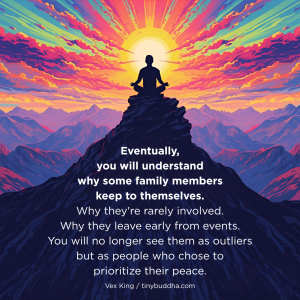
“No matter how much falls on us, we keep plowing ahead. That’s the only way to keep the roads clear” ~Greg Kincaid
How is it that some people can breeze through physical and emotional pain, whereas others wince at the mere thought of it?
Is it their genes? Their individual circumstances? Their support network?
Or is it a certain strength of character, something each and every one of us can develop with the right tools and training?
Two years ago I found myself needing to answer these questions.
I was sitting in a cafe in East London, wiping the tears from my cheeks with a napkin. To my boss, who’d just informed me she no longer needed me, it would’ve looked a little overdramatic. But at least an hour had passed since she’d left.
It was uncertain whether or not I’d be paid the previous month’s wages. I needed it to cover last month’s rent, to buy food for the following weeks, and now to call my mom. I’d moved to London only a month prior, giving up a good job and a bright future in a good company to work on a new, small but promising community project.
Despite the words of warning and concern from my family, I believed this was going to be the start of something great. Those tears were not for losing the position or even a month’s worth of hard work, but for the excruciating feeling of having to admit I was wrong and call my parents to take me in.
I was a mess. I felt like a failure to myself and to all those who’d been looking out for me.
Today when I think about that unfortunate time, I realize I wouldn’t be where I am now without it. I learned an early and somewhat easy lesson in resilience.
Resilience: ”An individual’s ability to properly adapt to stress and adversity.”
Resilience is not something you either have or don’t have. It’s a set of behaviors, thoughts, and actions that can be learned and developed by anyone. And the great thing is, you don’t need to lose your job, money, or pride to cultivate it.
There are three keystone habits to master in order to become a temple of strength and resilience in times of adversity. I’ve spent the past several years practicing them, and they’ve completely transformed my life, so naturally, I now want to share them with you.
Some of the tips may appear simple, but they take a concerted effort to put into practice and master. Start little by little today, and they’ll soon become a part of your body’s natural stress response.
Focus on Finding the Good
To be resilient, you need to be able to find reasons to be optimistic—some way your circumstances may actually be beneficial to you in the long run. It’s nearly impossible to bounce back when you’re focusing on how horrible a situation is. It’s much easier when you can find blessings in disguise within difficult times or identify lessons that can help you going forward.
But this doesn’t mean you don’t experience difficulty or distress. In fact, those who are highly resilient have a much more diverse repertoire of emotions than those who are not. They feel pain, mourn losses, and endure frustrations, but they understand that pain is temporary, and they focus on identifying the positive in the negative and opportunities in challenges.
If we don’t learn to look for the positive, we quickly become victims to the negativity bias—which means that even when the positives and negatives of a situation are of equal intensity, the unpleasant and traumatic thoughts and emotions affect us most. This is toxic because as soon as we start to complain, we become victims. If we smile and refuse to get caught up in negative interpretations of events, we are simply experiencers.
It took me a while to see what good could come of being left in East London with no money, job, or clue as to what I was going to do next. It was only several months later, when my life took an unexpected turn for the better, that I would start to question the whole idea of positive and negative experiences and see that each brings their own unique possibilities.
That’s often how it happens; at first, it seems there’s only one way to interpret adversity. In retrospect, though, we often find that a chain of seemingly negative events put us directly on the path to something worthwhile. Resilient people remember this when everything seems bleak.
Question Your Thoughts and Feelings
One major difference between those who are resilient and those who are not is self-awareness—the ability to identify their emotions and question the thoughts that preceded them.
We know highly resilient people still experience reactive emotions from adversity like fear and worry, but they approach them in an active manner, identifying the thoughts that led to these emotions, challenging them, and quickly adapting. This is how they’re able to bounce back and summon confidence at will.
The best way to avoid getting caught up in emotional reactions is to practice meditation in small bouts every day.
Traditional meditation is great, but come 3 p.m. when you’re tired and hungry and in the middle of a heated debate with a colleague, it’s easy to forget the twenty minutes of calm and tranquil bliss you experienced that morning. Incorporating small bouts of meditation into your day allows you to regularly regulate your emotional state.
Today, I don’t actively seek out difficult conversations or sticky situations, but when they do appear on my radar, I’m fully prepared and equipped to handle them. Of course, this is easier said than done, and recently this belief was challenged when a call from a family member completely knocked me off my trajectory.
I hadn’t seen my grandma for years, not because I didn’t care but because I got busy with life, and I unwittingly convinced myself that she wouldn’t get sick again. So when it happened, it hit me hard.
The subsequent feelings of depression and woe that consumed me at first felt inevitable, but before I knew it, I was focusing on my breath, questioning my thoughts, and reframing the situation in a positive light.
At first, the situation seemed to have no upsides. Then I realized this was a reminder that life is short, and I need to be in touch with my grandmother more regularly. This same reminder also rekindled her appreciation for life. Pain wasn’t the only thing that could come from this situation, but growth, opportunity, and greater meaning.
Run Toward the Pain
As human beings, we naturally seek refuge in comfort.
Our minds and bodies are content following familiar patterns and routines, conserving energy and hiding from the scary unknown.
Unfortunately, that means we become dependent on external aids like smartphones to do difficult tasks and any strenuous thinking for us. This discomfort-avoiding behavior rubs off onto other areas of our lives: one minute you’re avoiding the pain of being alone by scrolling through Facebook, and the next you may be avoiding your feelings after losing someone close to you, inhibiting your ability to move forward.
Resilient people accept painful situations and face them head-on, trusting that they can get through them.
Rethink the little moments of discomfort and anxiety in your day as signposts to resilience and optimal health, from setting limitations on checking your phone to having that awkward conversation with a loved one.
Whenever I catch myself feeling even an ounce of discomfort, I stop and think, “What is the next course of action that will make me feel most satisfied: avoidance or plowing straight ahead?”
—
The same characteristics that make us resilient are the same traits that allow us to live stronger and more enriched lives. So look on the bright side, challenge your reactive thoughts and emotions, and learn to lean into discomfort. Then even if life gets you down, it won’t be able to keep you there.
About Joseph Pennington
Joseph Pennington is a freelance writer, Master's student of Mindfulness, and the creator of the mindfulness voice app, Bebot: The Three Minute Breathing Space. Find out more about the breathing space and hear directly from Bebot, your mindful robot friend, by subscribing to her newsletter.













 Though I run this site, it is not mine. It's ours. It's not about me. It's about us. Your stories and your wisdom are just as meaningful as mine.
Though I run this site, it is not mine. It's ours. It's not about me. It's about us. Your stories and your wisdom are just as meaningful as mine.
Thanks for sharing your story. It really does take time and quite of bit of being able to look back onto ourselves, free of what our egos think, in order to be able to find the good in a situation, even if at the time it seems utterly bad. Oftentimes, the bad is good for it’s there to teach us something.
resilience is for the ego, which is of the mind.. and the mind really isn’t our friend is it?
Best way to be happy all the time is to want nothing no? For it takes nothing to be happy, but it takes something to be unhappy. So we should be empty and be no one.. and not listen to the mind, which is ego. Let life unfold and stop thinking too much. Don’t run away from bad feeling…bad feeling just a visitor.. they will leave all on their own, but don’t be rude host and try to shoo them off.
No need to “be resilient”.. only need is to “be”.. just be brothers and sisters.
~namaste
I lost my best friend and also my husband on Feb. 17, 2016. I have experienced another loss recently when I had to let our good friend and beautiful labrador puppy go, my dear friend Frankie Dankie, my best friend ever. I cannot keep him in the manner in which he’s become accustomed to, in spite of everything that his Momma has been subjected to. He belongs with humans who can keep up with his energy. I will miss him like a pain, every day of my life, another loss that I feel like a knife in my heart. Life’s not fair, but we know that already, folks. My Dad died in 2014, and my husband died in my arms in February, 2016. So, life isn’t fair, I’m aware of that.
First world problems.
This is a blessing. Thank you for sharing your wisdom through this article. I’m going to bookmark it and share it with others.
I basically profit around $6k-$8k on monthly basis from freelancing at home. For everybody prepared to work easy freelance jobs for 2-5 hours each day from your couch at home and make good profit while doing it… This is a work for you… UR1.CA/p7vuk
kldjfgkljadsfg
Thank you. Your words have really struck a cord with me.